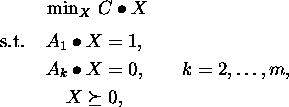
To solve a given SDP, the user needs to express it in the standard form
(1) and (2), and then write a function file,
say problem.m, to compute the input data blk,A,C,b,X0,y0,Z0
for the solvers sdp.m or sdphlf.m.
This function file may take the form
function [blk,A,C,b,X0,y0,Z0] = problem(input arguments).
The user can easily learn how to use this software package by reading the script file demo.m, which illustrates how the solvers sdp.m and sdphlf.m can be used to solve a few SDP examples. The next section shows how sdp.m and sdphlf.m can be used to solve random problems generated by randsdp.m, graph.m, and maxcut.m, and the resulting output, for several of our algorithms.
This software package also includes example files for the following classes of SDPs. In these files, the input variables feas and solve are used as follows:

If solve is positive, the output variable objval is the objective value of the associated optimization problem, and the output variables after objval give approximately optimal solutions to the original problem and its dual (or possibly indications of infeasibility).
Here are our examples.
(1) Random SDP:
The associated M-file is randsdp.m, with initial line
function
[blk,A,C,b,X0,y0,Z0,objval,X,y,Z] = randsdp(de,sp,di,m,feas,solve),
where the input parameters describe a particular block diagonal structure
for each ![]() and C. Specifically, the vector
de is a list of dimensions of dense blocks;
the vector sp
is a list of dimensions of (small)
subblocks in a single sparse block; and the scalar di
is the size of the diagonal block. The scalar
m is the number of equality constraints.
and C. Specifically, the vector
de is a list of dimensions of dense blocks;
the vector sp
is a list of dimensions of (small)
subblocks in a single sparse block; and the scalar di
is the size of the diagonal block. The scalar
m is the number of equality constraints.
(2) Norm minimization problem:
where the
![]() ,
, ![]() , are
, are ![]() matrices
(possibly complex, in which case x ranges over
matrices
(possibly complex, in which case x ranges over ![]() )
and the norm is the matrix 2-norm.
The associated M-file is norm_min.m, with initial line
)
and the norm is the matrix 2-norm.
The associated M-file is norm_min.m, with initial line
function [blk,A,C,b,X0,y0,Z0,objval,x] =
norm_min(B,feas,solve),
where ![]() is a cell array with
is a cell array with
![]() , k = 0,...,m.
, k = 0,...,m.
(3) Chebyshev approximation problem for a matrix:
where the minimization is over the class of monic
polynomials of degree m, B is a square matrix (possibly complex)
and the norm is the matrix 2-norm.
The associated M-file is chebymat.m, with initial line
function
[blk,A,C,b,X0,y0,Z0,objval,p] = chebymat(B,m,feas,solve).
See also igmres.m, which solves an analogous
problem with p normalized such that p(0) = 1.
(4) Max-Cut problem:

where
![]() , e is the vector of all ones
and B is the weighted adjacency matrix of a graph [6].
The associated M-file is maxcut.m, with initial line
, e is the vector of all ones
and B is the weighted adjacency matrix of a graph [6].
The associated M-file is maxcut.m, with initial line
function
[blk,A,C,b,X0,y0,Z0,objval,X] = maxcut(B,feas,solve).
See also graph.m, from which the user can generate
a weighted adjacency matrix B of a random graph.
(5) ETP (Educational testing problem):

where B is a real
![]() positive definite matrix and
e is again the vector of all ones.
The associated M-file is etp.m, with initial line
positive definite matrix and
e is again the vector of all ones.
The associated M-file is etp.m, with initial line
function [blk,A,C,b,X0,y0,Z0,objval,d] = etp(B,feas,solve).
(6) Lovász ![]() function for a graph:
function for a graph:

where C is the matrix of all minus ones,
![]() , and
, and
![]() , where the (k-1)st edge of the
given graph (with m-1 edges) is from vertex i to vertex j.
Here
, where the (k-1)st edge of the
given graph (with m-1 edges) is from vertex i to vertex j.
Here ![]() denotes the ith unit vector.
The associated M-file is theta.m, with initial line
denotes the ith unit vector.
The associated M-file is theta.m, with initial line
function
[blk,A,C,b,X0,y0,Z0,objval,X] = theta(B,feas,solve),
where B is the adjacency matrix of the graph.
(7) Logarithmic Chebyshev approximation problem:
where
![]() is a real
is a real ![]() matrix and
f is a real N-vector.
The associated M-file is logcheby.m, with initial line
matrix and
f is a real N-vector.
The associated M-file is logcheby.m, with initial line
function
[blk,A,C,b,X0,y0,Z0,objval,x] = logcheby(B,f,feas,solve).
(8) Chebyshev approximation problem in the complex plane:
where the minimization is over the class of monic polynomials
of degree m and
![]() is a given set of points in the complex plane.
The associated M-file is chebyinf.m, with initial line
is a given set of points in the complex plane.
The associated M-file is chebyinf.m, with initial line
function
[blk,A,C,b,X0,y0,Z0,objval,p] = chebyinf(d,m,feas,solve),
where ![]() .
See also cheby0.m, which solves an analogous
problem with p normalized such that p(0) = 1.
.
See also cheby0.m, which solves an analogous
problem with p normalized such that p(0) = 1.
(9) Control and system problem:

where
![]() ,
, ![]() , are square real matrices of the same dimension.
The associated M-file is control.m, with initial line
, are square real matrices of the same dimension.
The associated M-file is control.m, with initial line
function
[blk,A,C,b,X0,y0,Z0,objval,P] = control(B,solve),
where ![]() is a cell array with
is a cell array with
![]() , k = 1,...,L.
, k = 1,...,L.